Martin Kleinsteuber
TUM
On Leveraging Variational Graph Embeddings for Open World Compositional Zero-Shot Learning
Apr 23, 2022
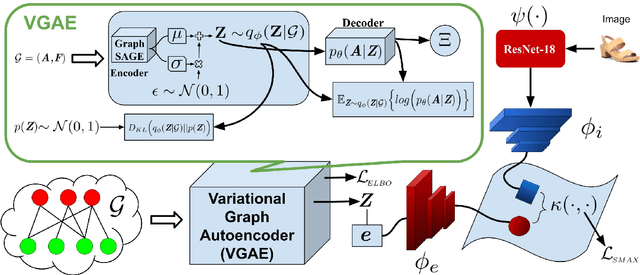
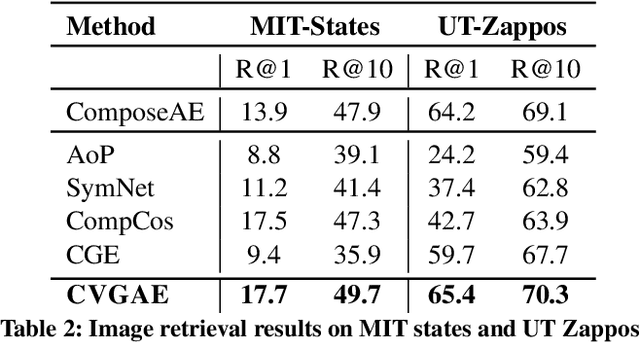
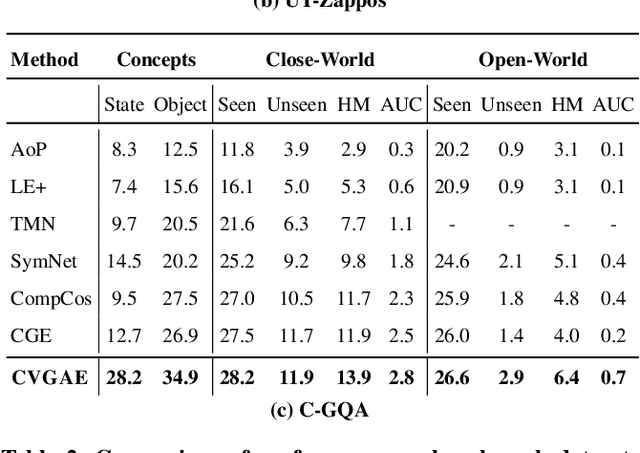
Abstract:Humans are able to identify and categorize novel compositions of known concepts. The task in Compositional Zero-Shot learning (CZSL) is to learn composition of primitive concepts, i.e. objects and states, in such a way that even their novel compositions can be zero-shot classified. In this work, we do not assume any prior knowledge on the feasibility of novel compositions i.e.open-world setting, where infeasible compositions dominate the search space. We propose a Compositional Variational Graph Autoencoder (CVGAE) approach for learning the variational embeddings of the primitive concepts (nodes) as well as feasibility of their compositions (via edges). Such modelling makes CVGAE scalable to real-world application scenarios. This is in contrast to SOTA method, CGE, which is computationally very expensive. e.g.for benchmark C-GQA dataset, CGE requires 3.94 x 10^5 nodes, whereas CVGAE requires only 1323 nodes. We learn a mapping of the graph and image embeddings onto a common embedding space. CVGAE adopts a deep metric learning approach and learns a similarity metric in this space via bi-directional contrastive loss between projected graph and image embeddings. We validate the effectiveness of our approach on three benchmark datasets.We also demonstrate via an image retrieval task that the representations learnt by CVGAE are better suited for compositional generalization.
Barlow Graph Auto-Encoder for Unsupervised Network Embedding
Nov 23, 2021


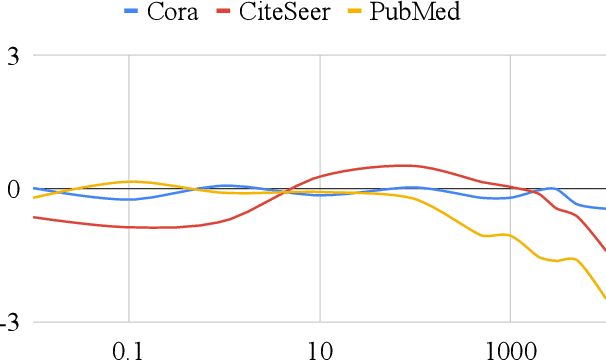
Abstract:Network embedding has emerged as a promising research field for network analysis. Recently, an approach, named Barlow Twins, has been proposed for self-supervised learning in computer vision by applying the redundancy-reduction principle to the embedding vectors corresponding to two distorted versions of the image samples. Motivated by this, we propose Barlow Graph Auto-Encoder, a simple yet effective architecture for learning network embedding. It aims to maximize the similarity between the embedding vectors of immediate and larger neighborhoods of a node, while minimizing the redundancy between the components of these projections. In addition, we also present the variation counterpart named as Barlow Variational Graph Auto-Encoder. Our approach yields promising results for inductive link prediction and is also on par with state of the art for clustering and downstream node classification, as demonstrated by extensive comparisons with several well-known techniques on three benchmark citation datasets.
A Framework for Joint Unsupervised Learning of Cluster-Aware Embedding for Heterogeneous Networks
Aug 09, 2021


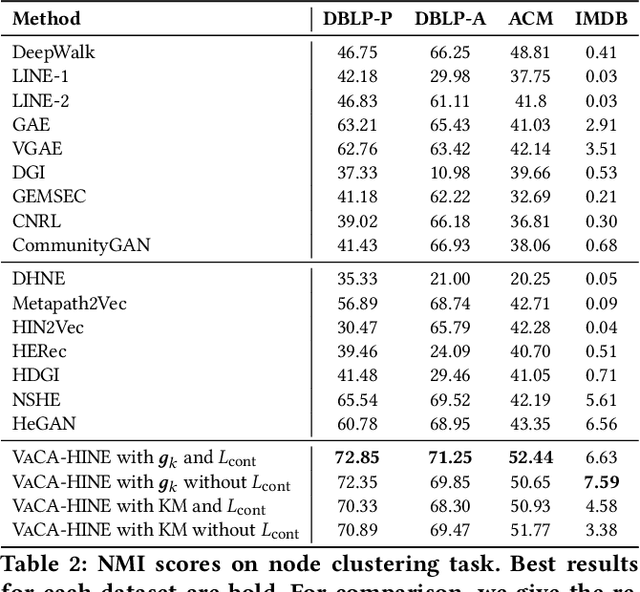
Abstract:Heterogeneous Information Network (HIN) embedding refers to the low-dimensional projections of the HIN nodes that preserve the HIN structure and semantics. HIN embedding has emerged as a promising research field for network analysis as it enables downstream tasks such as clustering and node classification. In this work, we propose \ours for joint learning of cluster embeddings as well as cluster-aware HIN embedding. We assume that the connected nodes are highly likely to fall in the same cluster, and adopt a variational approach to preserve the information in the pairwise relations in a cluster-aware manner. In addition, we deploy contrastive modules to simultaneously utilize the information in multiple meta-paths, thereby alleviating the meta-path selection problem - a challenge faced by many of the famous HIN embedding approaches. The HIN embedding, thus learned, not only improves the clustering performance but also preserves pairwise proximity as well as the high-order HIN structure. We show the effectiveness of our approach by comparing it with many competitive baselines on three real-world datasets on clustering and downstream node classification.
Variational Embeddings for Community Detection and Node Representation
Jan 11, 2021


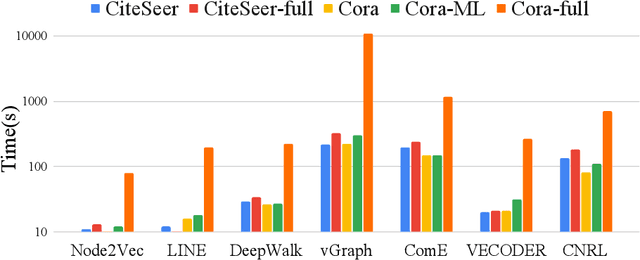
Abstract:In this paper, we study how to simultaneously learn two highly correlated tasks of graph analysis, i.e., community detection and node representation learning. We propose an efficient generative model called VECoDeR for jointly learning Variational Embeddings for Community Detection and node Representation. VECoDeR assumes that every node can be a member of one or more communities. The node embeddings are learned in such a way that connected nodes are not only "closer" to each other but also share similar community assignments. A joint learning framework leverages community-aware node embeddings for better community detection. We demonstrate on several graph datasets that VECoDeR effectively out-performs many competitive baselines on all three tasks i.e. node classification, overlapping community detection and non-overlapping community detection. We also show that VECoDeR is computationally efficient and has quite robust performance with varying hyperparameters.
Metapath- and Entity-aware Graph Neural Network for Recommendation
Oct 22, 2020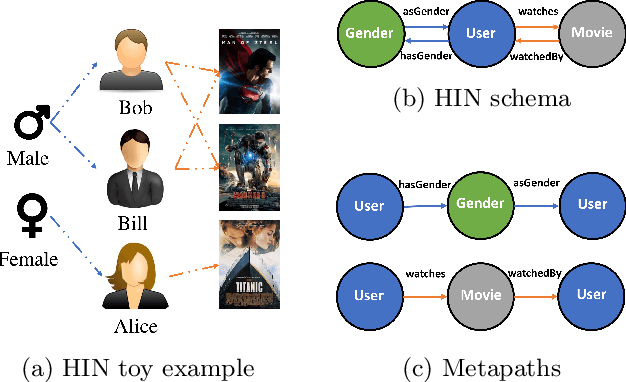
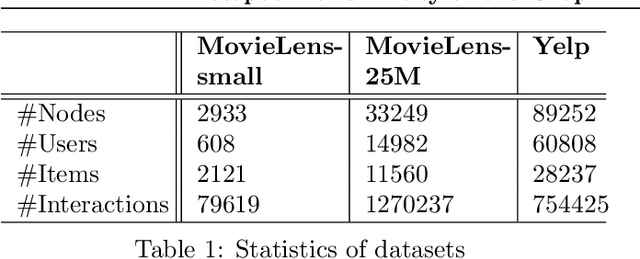
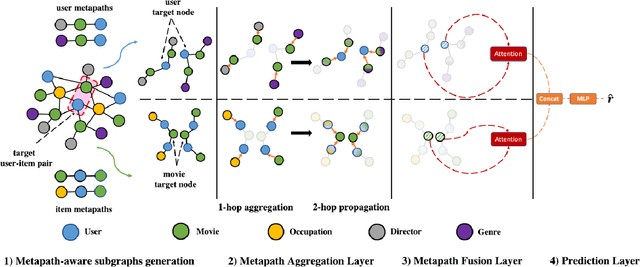
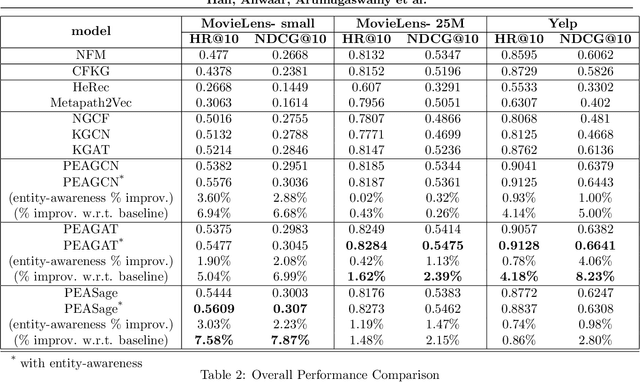
Abstract:Due to the shallow structure, classic graph neural networks (GNNs) failed in modelling high-order graph structures that deliver critical insights of task relevant relations. The negligence of those insights lead to insufficient distillation of collaborative signals in recommender systems. In this paper, we propose PEAGNN, a unified GNN framework tailored for recommendation tasks, which is capable of exploiting the rich semantics in metapaths. PEAGNN trains multilayer GNNs to perform metapath-aware information aggregation on collaborative subgraphs, $h$-hop subgraphs around the target user-item pairs. After the attentive fusion of aggregated information from different metapaths, a graph-level representation is then extracted for matching score prediction. To leverage the local structure of collaborative subgraphs, we present entity-awareness that regularizes node embedding with the presence of features in a contrastive manner. Moreover, PEAGNN is compatible with the mainstream GNN structures such as GCN, GAT and GraphSage. The empirical analysis on three public datasets demonstrate that our model outperforms or is at least on par with other competitive baselines. Further analysis indicates that trained PEAGNN automatically derives meaningful metapath combinations from the given metapaths.
Compositional Learning of Image-Text Query for Image Retrieval
Jun 28, 2020



Abstract:In this paper, we investigate the problem of retrieving images from a database based on a multi-modal (image-text) query. Specifically, the query text prompts some modification in the query image and the task is to retrieve images with the desired modifications. For instance, a user of an E-Commerce platform is interested in buying a dress, which should look similar to her friend's dress, but the dress should be of white color with a ribbon sash. In this case, we would like the algorithm to retrieve some dresses with desired modifications in the query dress. We propose an autoencoder based model, ComposeAE, to learn the composition of image and text query for retrieving images. We adopt a deep metric learning approach and learn a metric that pushes composition of source image and text query closer to the target images. We also propose a rotational symmetry constraint on the optimization problem. Our approach is able to outperform the state-of-the-art method TIRG \cite{TIRG} on three benchmark datasets, namely: MIT-States, Fashion200k and Fashion IQ. In order to ensure fair comparison, we introduce strong baselines by enhancing TIRG method. To ensure reproducibility of the results, we publish our code here: \url{https://anonymous.4open.science/r/d1babc3c-0e72-448a-8594-b618bae876dc/}.
Epitomic Variational Graph Autoencoder
Apr 03, 2020

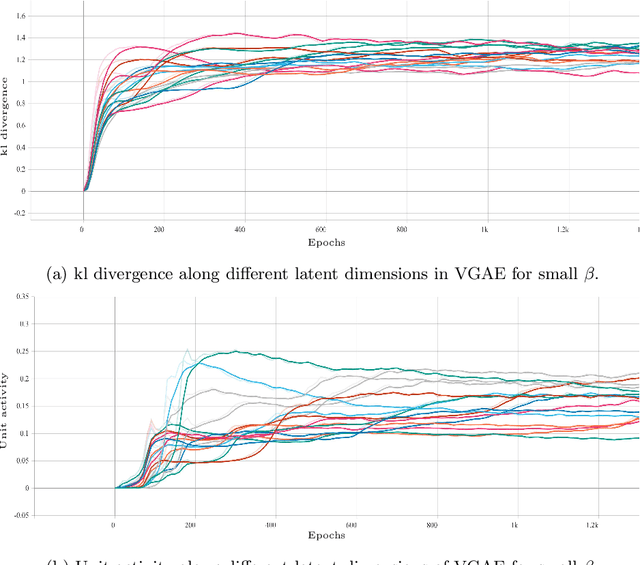

Abstract:Variational autoencoder (VAE) is a widely used generative model for unsupervised learning of vector data. The learning capacity of VAE is often limited by \textit{over-pruning} - a phenomenon that prevents many of the latent dimensions from learning any useful information about the input data. Variational graph autoencoder (VGAE) extends VAE for unsupervised learning of graph-structured data. Being an extension of VAE model, VGAE, also suffers from over-pruning in principal. In this paper we look at over-pruning in VGAE and observe that the generative capacity of VGAE is limited because of the way VGAE deals with this issue. We then propose epitomic variational graph autoencoder (EVGAE), a generative variational framework for graph datasets to overcome over-pruning. We show through experiments that the resulting model has a better generative ability and also achieves better scores in graph analysis related tasks.
Counterfactual Learning from Logs for Improved Ranking of E-Commerce Products
Jul 24, 2019



Abstract:Improved search quality enhances users' satisfaction, which directly impacts sales growth of an E-Commerce (E-Com) platform. Learning to Rank (LTR) algorithms require relevance judgments on products for learning. In real commercial scenarios, getting such judgments poses an immense challenge in application of LTR algorithms. In the literature, it is proposed to employ user feedback signals such as clicks, orders etc to generate relevance judgments. It is done by aggregating the logged data and calculating click rate, order rate etc of products, for each query in the logs. In this paper, we advocate counterfactual risk minimization (CRM) approach which circumvents the need of such data pre-processing and is better suited for learning from logged data, i.e. contextual bandit feedback. Due to unavailability of public E-Com LTR dataset, we provide Mercateo dataset from our E-Com platform. This dataset contains information of queries from real users, actions taken by the policy running on the system, probability of these actions and feedback of users on those actions. Our commercial dataset contains more than 10 million click log entries and 1 million order logs from a catalogue of about 3.5 million products and 3000 queries. To the best of our knowledge, this is the first work which examines effectiveness of CRM approach in learning ranking model from real-world logged data. Our empirical evaluation shows that CRM approach is able to learn directly from logged contextual-bandit feedback. Our method outperforms full-information loss on deep neural network model as well as traditional ranking models like LambdaMART. These findings have significant implications for improving the quality of search in E-Com platforms.
Trace Quotient with Sparsity Priors for Learning Low Dimensional Image Representations
Oct 08, 2018



Abstract:This work studies the problem of learning appropriate low dimensional image representations. We propose a generic algorithmic framework, which leverages two classic representation learning paradigms, i.e., sparse representation and the trace quotient criterion. The former is a well-known powerful tool to identify underlying self-explanatory factors of data, while the latter is known for disentangling underlying low dimensional discriminative factors in data. Our developed solutions disentangle sparse representations of images by employing the trace quotient criterion. We construct a unified cost function, coined as the SPARse LOW dimensional representation (SparLow) function, for jointly learning both a sparsifying dictionary and a dimensionality reduction transformation. The SparLow function is widely applicable for developing various algorithms in three classic machine learning scenarios, namely, unsupervised, supervised, and semi-supervised learning. In order to develop efficient joint learning algorithms for maximizing the SparLow function, we deploy a framework of sparse coding with appropriate convex priors to ensure the sparse representations to be locally differentiable. Moreover, we develop an efficient geometric conjugate gradient algorithm to maximize the SparLow function on its underlying Riemannian manifold. Performance of the proposed SparLow algorithmic framework is investigated on several image processing tasks, such as 3D data visualization, face/digit recognition, and object/scene categorization.
Clustering with Simultaneous Local and Global View of Data: A message passing based approach
Mar 12, 2018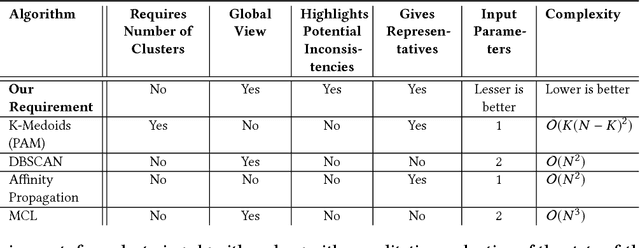
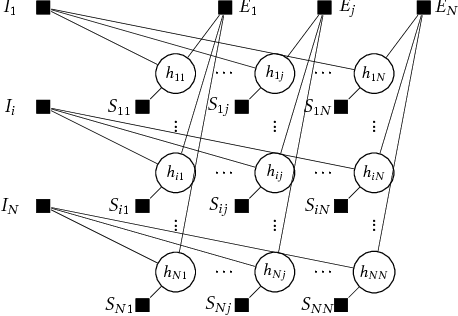
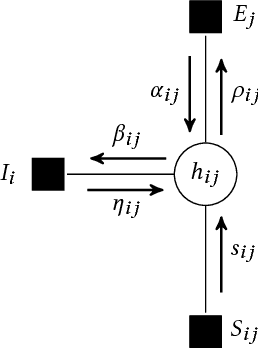

Abstract:A good clustering algorithm should not only be able to discover clusters of arbitrary shapes (global view) but also provide additional information, which can be used to gain more meaningful insights into the internal structure of the clusters (local view). In this work we use the mathematical framework of factor graphs and message passing algorithms to optimize a pairwise similarity based cost function, in the same spirit as was done in Affinity Propagation. Using this framework we develop two variants of a new clustering algorithm, EAP and SHAPE. EAP/SHAPE can not only discover clusters of arbitrary shapes but also provide a rich local view in the form of meaningful local representatives (exemplars) and connections between these local exemplars. We discuss how this local information can be used to gain various insights about the clusters including varying relative cluster densities and indication of local strength in different regions of a cluster . We also discuss how this can help an analyst in discovering and resolving potential inconsistencies in the results. The efficacy of EAP/SHAPE is shown by applying it to various synthetic and real world benchmark datasets.
 Add to Chrome
Add to Chrome Add to Firefox
Add to Firefox Add to Edge
Add to Edge